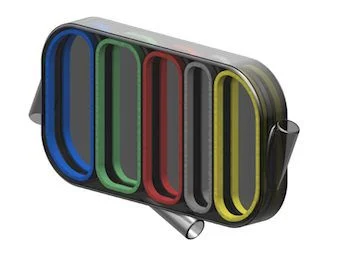Kidney assembly. The Implantable Artificial Kidney, shown here without filters and
covers, works like a human kidney by removing excess minerals and wastes
from the body.
It may not look like one, but the Implantable Artificial Kidney device has been designed to function in the same way as a human kidney. By extracting waste and keeping nutrients needed by the body, it could one day help those with chronic renal failure.
According to the Implantable Artificial Kidney Corporation, the organization developing and testing the device, it uses special filters, osmosis/diffusion and reverse osmosis to separate waste material and water.
In the average healthy adult, kidneys process around 45 gallons each day in order to filter out nearly 2 quarts of waste product and extra water in the urine.
Since the kidney's main function is to remove excess minerals and wastes, such as creatinine and urea, patients who suffer from chronic renal failure (CRF) need dialysis to help rid the body of these wastes or they need to undergo transplantation.
However, unlike transplantation, which risks rejection from the body, the Artificial Kidney device has been designed to not be rejected by the body, effectively doing away with post-operative immunosuppressant drugs and the frequent monitoring that a kidney transplant patient requires for the rest of his or her life.
The device, which can either be implanted or worn outside the body, will create urine immediately, unlike a human implanted kidney, which can sometimes take 2 weeks or longer to begin working.
According to the company, the device's design is the only one of its kind - it is small and is built using plastic materials described as being "medically safe."
Roland G. Ludlow, CEO of the Implantable Artificial Kidney Corporation, says: "The simplicity of design and its small size make it unique. Past in-house tests separated the materials effectively. We are making great progress, and we are extremely excited about its potential."
He says that recent upgrades have been undertaken, and once complete, the device will be ready for a full test by a third party laboratory.
Chronic renal failure in the US
According to the Centers for Disease Control and Prevention (CDC) National Center for Health Statistics, there were 50,476 kidney failure-related deaths in 2010, making mortality due to kidney failure number eight on the cause of death list in the US.
Additionally, in 2011, there were 4.4 million noninstitutionalized adults who were diagnosed with kidney disease, which is nearly 2% of adults.
Not only are kidney transplants tricky because of the risks involved with the body rejecting the organ, but also finding a suitable donor is quite difficult, and many people must continue dialysis while they sit on a waiting list for transplantation.
Once their device is out of the laboratory testing phase, the organization plans to implant the artificial kidney into pigs in less than a year, as their circulatory system is similar to a human's. They note that they would prefer to do this at a state university that has a medical and agricultural facility.
Source: Implantable Artificial Kidney Corporation via Medical News Today
It may not look like one, but the Implantable Artificial Kidney device has been designed to function in the same way as a human kidney. By extracting waste and keeping nutrients needed by the body, it could one day help those with chronic renal failure.
According to the Implantable Artificial Kidney Corporation, the organization developing and testing the device, it uses special filters, osmosis/diffusion and reverse osmosis to separate waste material and water.
In the average healthy adult, kidneys process around 45 gallons each day in order to filter out nearly 2 quarts of waste product and extra water in the urine.
Since the kidney's main function is to remove excess minerals and wastes, such as creatinine and urea, patients who suffer from chronic renal failure (CRF) need dialysis to help rid the body of these wastes or they need to undergo transplantation.
However, unlike transplantation, which risks rejection from the body, the Artificial Kidney device has been designed to not be rejected by the body, effectively doing away with post-operative immunosuppressant drugs and the frequent monitoring that a kidney transplant patient requires for the rest of his or her life.
The device, which can either be implanted or worn outside the body, will create urine immediately, unlike a human implanted kidney, which can sometimes take 2 weeks or longer to begin working.
According to the company, the device's design is the only one of its kind - it is small and is built using plastic materials described as being "medically safe."
Roland G. Ludlow, CEO of the Implantable Artificial Kidney Corporation, says: "The simplicity of design and its small size make it unique. Past in-house tests separated the materials effectively. We are making great progress, and we are extremely excited about its potential."
He says that recent upgrades have been undertaken, and once complete, the device will be ready for a full test by a third party laboratory.
Chronic renal failure in the US
According to the Centers for Disease Control and Prevention (CDC) National Center for Health Statistics, there were 50,476 kidney failure-related deaths in 2010, making mortality due to kidney failure number eight on the cause of death list in the US.
Additionally, in 2011, there were 4.4 million noninstitutionalized adults who were diagnosed with kidney disease, which is nearly 2% of adults.
Not only are kidney transplants tricky because of the risks involved with the body rejecting the organ, but also finding a suitable donor is quite difficult, and many people must continue dialysis while they sit on a waiting list for transplantation.
Once their device is out of the laboratory testing phase, the organization plans to implant the artificial kidney into pigs in less than a year, as their circulatory system is similar to a human's. They note that they would prefer to do this at a state university that has a medical and agricultural facility.
Source: Implantable Artificial Kidney Corporation via Medical News Today
Latest Articles
kidney failure
Kidney assembly. The Implantable Artificial Kidney, shown here without filters and covers, works like a human kidney by removing excess minerals and waste...










